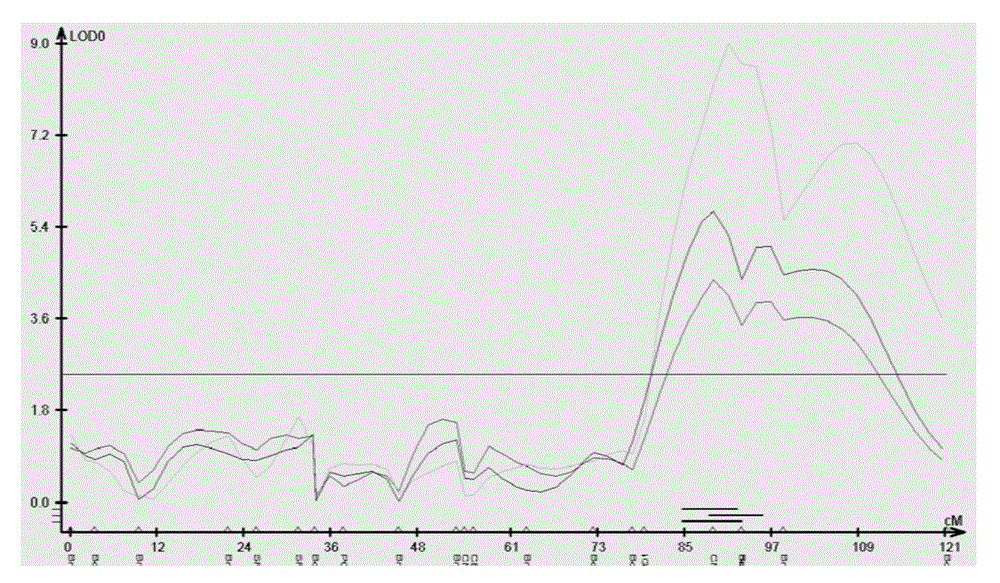Rapeseed pod number major QTL molecular marker and application thereof
A technology of molecular markers and siliques, which is applied in the determination/testing of microorganisms, DNA/RNA fragments, recombinant DNA technology, etc., can solve problems such as difficult application, poor performance, and small repeatability, and achieve accurate and rapid screening and accelerated breeding The effect of clear process and position
- Summary
- Abstract
- Description
- Claims
- Application Information
AI Technical Summary
Problems solved by technology
Method used
Image
Examples
Embodiment 1
[0034] Construction and trait determination of silique number segregation populations of rapeseed:
[0035] In the embodiment of the present invention, the F 2 and F 2:3 Separate groups. The silique number phenotypes of the two parents and the two populations were identified after harvesting at the mature stage. The test data of the number of siliques showed that the number of siliques in the two populations was normally distributed, which proved the quantitative genetic characteristics of the number of siliques ( figure 1 ).
Embodiment 2
[0037] Extraction of total DNA from leaves:
[0038] The total DNA of leaves was extracted by the CTAB method, and the specific steps were as follows:
[0039] (1) Take 0.1 g of fresh leaves and grind them, add 700 microliters of extract to grind them, then transfer them to a 1.5 ml centrifuge tube and place them in a constant temperature water bath at 65°C for 60 minutes, during which they mix 2-3 times;
[0040] (2) Add an equal volume of phenol: chloroform: isoamyl alcohol (25:24:1, V / V / V), invert gently to mix well, centrifuge at 12,000rpm for 10 minutes, and gently absorb the supernatant into another 1.5 ml centrifuge tube; add an equal volume of chloroform: isoamyl alcohol (24:1, V / V) and re-extract once;
[0041] (3) Add 1 ml of -20°C pre-cooled absolute ethanol, freeze at -20°C for no more than 30 minutes to allow the DNA to precipitate; / V) Wash with ethanol for 2-3 times, pour off the soaking solution, open the cap of the centrifuge tube and place it in a fume hood...
Embodiment 3
[0044] Primer development and synthesis:
[0045] The SSR primers used by the applicant include two types: synthetic rapeseed public (http: / / www.ukcrop.net / Brassica DB) and self-developed SSR, and STS primers (Wang et al.2012; Huang et al.2013; Shi et al.2014,) PCR amplification was performed on the parental DNA, and the product was electrophoresed in a denaturing polyacrylamide gel. After staining and developing, the size of the band was discriminated, and polymorphic primers were screened. The main software used in the process includes SSRPrimer, BWA and sa mtools; the main reagents include Taq enzyme, dNTP, acrylamide, urea, glacial acetic acid, silver nitrate, etc.
PUM
 Login to View More
Login to View More Abstract
Description
Claims
Application Information
 Login to View More
Login to View More - R&D
- Intellectual Property
- Life Sciences
- Materials
- Tech Scout
- Unparalleled Data Quality
- Higher Quality Content
- 60% Fewer Hallucinations
Browse by: Latest US Patents, China's latest patents, Technical Efficacy Thesaurus, Application Domain, Technology Topic, Popular Technical Reports.
© 2025 PatSnap. All rights reserved.Legal|Privacy policy|Modern Slavery Act Transparency Statement|Sitemap|About US| Contact US: help@patsnap.com



